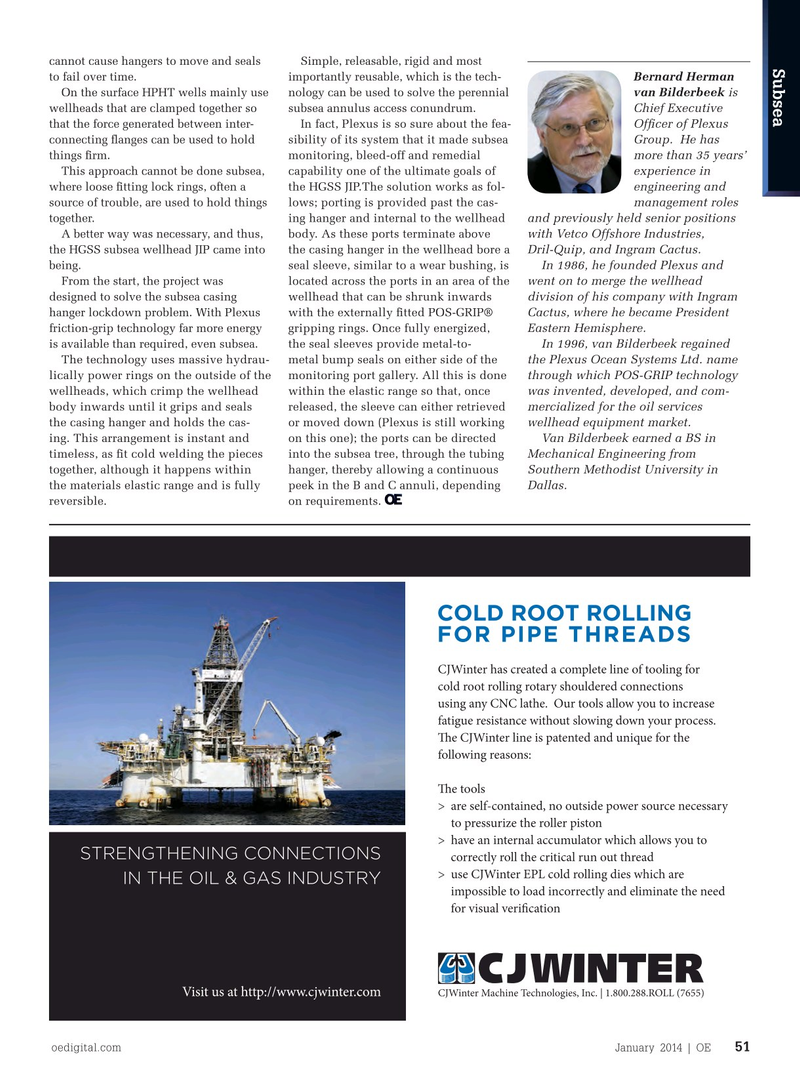
Page 49: of Offshore Engineer Magazine (Jan/Feb 2014)
Read this page in Pdf, Flash or Html5 edition of Jan/Feb 2014 Offshore Engineer Magazine
cannot cause hangers to move and seals Simple, releasable, rigid and most
Subsea
Bernard Herman to fail over time. importantly reusable, which is the tech- van Bilderbeek is
On the surface HPHT wells mainly use nology can be used to solve the perennial
Chief Executive wellheads that are clamped together so subsea annulus access conundrum.
Offcer of Plexus n fact, Plexus is so sure about the fea- that the force generated between inter- I
Group. He has sibility of its system that it made subsea connecting fanges can be used to hold
JIP addresses more than 35 years’ monitoring, bleed-off and remedial things frm.
experience in capability one of the ultimate goals of
This approach cannot be done subsea, engineering and the HGSS JIP.The solution works as fol- where loose ftting lock rings, often a subsea wellhead monitoring management roles lows; porting is provided past the cas- source of trouble, are used to hold things and previously held senior positions ing hanger and internal to the wellhead together.
with Vetco Offshore Industries, through which events in the various body. As these ports terminate above
A better way was necessary, and thus,
Dril-Quip, and Ingram Cactus. casing annuli can be monitored. the casing hanger in the wellhead bore a the HGSS subsea wellhead JIP came into In 1986, he founded Plexus and
Effectively, subsea wells are “out of being.
seal sleeve, similar to a wear bushing, is went on to merge the wellhead sight, out of mind” where it comes to From the start, the project was located across the ports in an area of the division of his company with Ingram annuli, and as a result, the MMS did not designed to solve the subsea casing wellhead that can be shrunk inwards
Cactus, where he became President have data to back up its supposition. hanger lockdown problem. With Plexus with the externally ftted POS-GRIP®
Eastern Hemisphere.
The agency did conclude that SCP is a friction-grip technology far more energy gripping rings. Once fully energized, In 1996, van Bilderbeek regained threat to operations and the environ- is available than required, even subsea. the seal sleeves provide metal-to- the Plexus Ocean Systems Ltd. name
The technology uses massive hydrau- ment, and statistics show that it has metal bump seals on either side of the through which POS-GRIP technology lically power rings on the outside of the a point. In 2002, the MMS asked US monitoring port gallery. All this is done was invented, developed, and com- wellheads, which crimp the wellhead operators to do something about subsea within the elastic range so that, once mercialized for the oil services body inwards until it grips and seals annulus management. After years of released, the sleeve can either retrieved wellhead equipment market. the casing hanger and holds the cas- “toing and froing,” it was concluded or moved down (Plexus is still working Van Bilderbeek earned a BS in ing. This arrangement is instant and that the available solutions were too on this one); the ports can be directed
Mechanical Engineering from timeless, as ft cold welding the pieces complex, involved too many additional into the subsea tree, through the tubing
Southern Methodist University in together, although it happens within risks, and were too expensive in the long hanger, thereby allowing a continuous
Dallas.
the materials elastic range and is fully term. The MMS abandoned the project peek in the B and C annuli, depending reversible.
in December 2005. In its fnal report, it on requirements. lamented that subsea monitoring would only come about through regulator intervention.
Fast forward to 2013, and suddenly, at least in the UK, the quest to stop “fying blind” is once again rearing its head in the form of a call for solutions by UK industry organization ITF.
Following Macondo, Plexus Holdings was asked by a group of operators to study the application of its patented friction-grip technology to subsea well- heads. As a direct result of this inquiry a joint industry project (JIP) was formed, supported by major operators, including
Shell, Wintershall, EIN, Total, Tullow and Maersk. The project is now 18 months underway with the aim to come up with a new approach in wellhead engineering, focused on addressing the systemic shortcomings of conventional subsea wellhead techniques, as exposed by Macondo.
The problem is the limited amount of energy one can remotely deliver subsea through the drill string from thousands of feet away. Ten thousand feet of drill pipe feels like a rubber band and inside the bore of a wellhead space is limited. Yet an enormous amount of energy is needed to clamp moving parts together and to energize metal seals so that well forces oedigital.com January 2014 | OE 51 050_0114_subsea3_Plexus.indd 51 12/19/13 4:07 PM

 48
48

 50
50